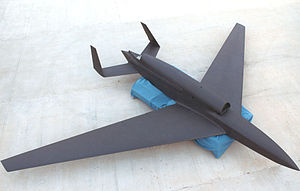- AQM-91 Firefly
-
AQM-91 Firefly Teledyne Ryan AQM-91A Compass Arrow at the National Museum of the United States Air Force. Role Reconnaissance drone National origin United States Manufacturer Ryan Aeronautical First flight September 1968 Number built 28 The Ryan AQM-91 Firefly was a developmental drone developed during the Vietnam War to perform long-range reconnaissance, especially into China.
Contents
Development
The Ryan Model 147 Lightning Bug reconnaissance drone was enjoying success in Vietnam in the early 1960s, but it lacked the range to fly deep into China and back out again. In particular, the Chinese nuclear development facility at Lop Nor was far out of reach of the Lightning Bugs, and was barely within reach of the Lockheed U-2 spyplane, which had become far too vulnerable to SAMs. US intelligence thus needed a long-range drone with a high degree of survivability. Such requirements spelled out a completely new design, not a modification of a target drone.
Ryan pursued advanced drone concepts on a part-time basis. After discussions with the CIA that went nowhere, Ryan pitched their advanced reconnaissance drone concepts to the Air Force in early 1966. The USAF was interested, and opened up a design competition, with Ryan competing with North American Aviation. Ryan won the competition in June 1966, and the new design was designated the "Model 154 / AQM-91A Firefly". The basic design concept resembled that of the Model 136 Red Wagon drone that Ryan had proposed earlier in the decade, but which had been turned down in favor of modified Firebees. The name "Firefly" was resurrected from the early Model 147 program for the new drone, though it was also referred to as "Compass Arrow" after the program name.
The Model 154 had an engine on the top of the fuselage to reduce its radar and infrared signature as seen from below, as well as twin inward-canted tailfins to conceal the exhaust stream. It had sloped flat sides to deflect radar signals, and was built using a high percentage of plastic composites, which had a lower radar reflectivity than metal. The aircraft was powered by a General Electric YJ97-GE-3 turbojet providing 4,000 pounds (1,815 kg) thrust, with the engine exhaust mixed with cool air to reduce its infrared signature. The YJ97 was derived from a General Electric demonstrator engine designated the "GE1".
The Model 154 was to be launched by a DC-130 Hercules director aircraft, and recovered in midair by helicopter. It had a precision-navigation autopilot system, a reconnaissance payload, a self-destruct system to ensure that none of its sensitive gear fell into enemy hands, and was to carry electronic countermeasures to further improve its survivability. The primary reconnaissance payload was an Itek panoramic camera, but in principle it could also carry infrared cameras or a SIGINT payload.
The guidance system was designed to provide navigation accuracies with an error of no more than half a percent. The guidance system proved to be very tricky, and first powered flight of a Model 154 did not take place until September 1968.
The test flights were conducted over the US Southwest. The project was highly secret, but on 4 August 1969 one of the prototypes failed and parachuted to ground inside the Los Alamos nuclear research complex during lunch hour. Unfortunately, it didn't land in a restricted area, and local newspeople were able to take and publish photographs of the aircraft. The Air Force released a statement that the aircraft was a "high altitude target", but though such a statement might have been believed in 1959, it wasn't in 1969.
Test flights were halted for a few weeks while procedures were reviewed. The flights then resumed, culminating in long-range evaluations in late 1971. The Model 154 passed with flying colors, exceeding its altitude requirements by a good margin, and proving almost invisible to radar. However, by this time the need for the Model 154 had vanished. In July 1971, President Richard Nixon began a diplomatic effort to build ties with China, and reconnaissance overflights were cancelled. Satellite reconnaissance capabilities had improved through the 1960s, leading to the first launch of the advanced "Big Bird" satellite on 15 June 1971, which could provide strategic intelligence without provoking the Chinese.
The Model 154 program lingered on for a few more years, but the drones were finally put into mothballs in 1973, and scrapped a few years after than. 28 had been built, including 20 production machines.
Specifications
General characteristics
- Crew: None
- Length: 34 ft 2 in (10.40 m)
- Wingspan: 47 ft 8 in (14.50 m)
- Empty weight: 3,800 lb (1,725 kg)
- Gross weight: 5,400 lb (2,450 kg)
- Powerplant: 1 × General Electric YJ97-GE-3, 4,000 lbf (17.8 kN) each
Performance
- Maximum speed: 505 mph (815 km/h)
- Range: 4,370 miles (7,030 km)
See also
- Related development
- Ryan YQM-98
References
- This article contains material that originally came from the web article Unmanned Aerial Vehicles by Greg Goebel, which exists in the Public Domain.
External links
Lists relating to aviation General Aircraft (manufacturers) · Aircraft engines (manufacturers) · Airlines (defunct) · Airports · Civil authorities · Museums · Registration prefixes · Rotorcraft (manufacturers) · TimelineMilitary Accidents/incidents Records Categories:- United States military reconnaissance aircraft 1960–1969
- Unmanned aerial vehicles of the United States
Wikimedia Foundation. 2010.

